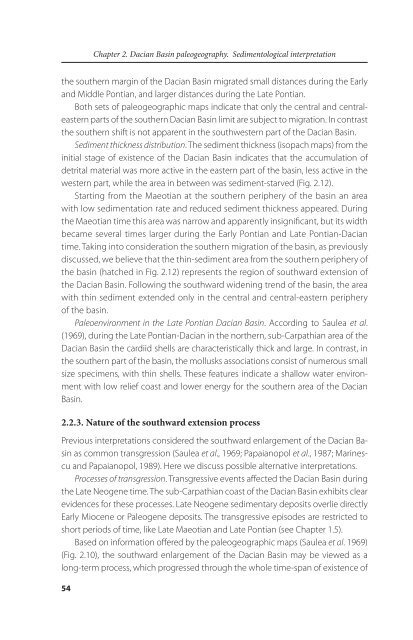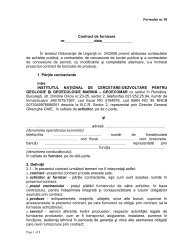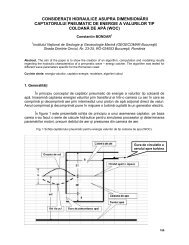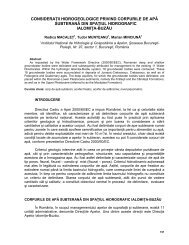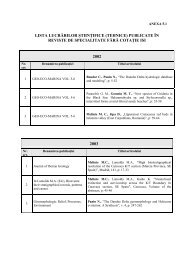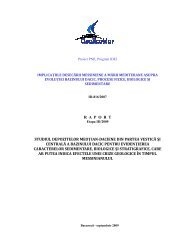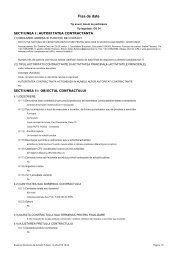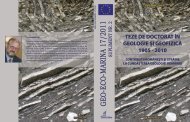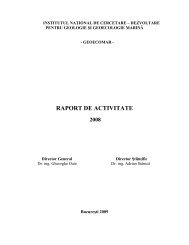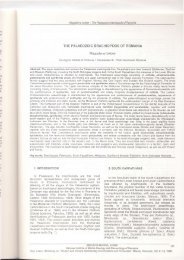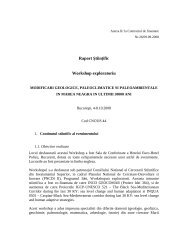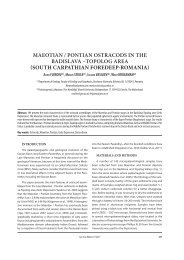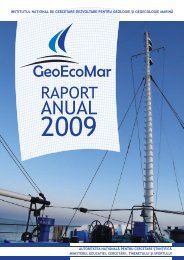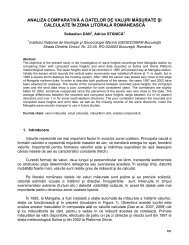DACIAN BASIN - GeoEcoMar
DACIAN BASIN - GeoEcoMar
DACIAN BASIN - GeoEcoMar
Create successful ePaper yourself
Turn your PDF publications into a flip-book with our unique Google optimized e-Paper software.
54<br />
Chapter 2. Dacian Basin paleogeography. Sedimentological interpretation<br />
the southern margin of the Dacian Basin migrated small distances during the Early<br />
and Middle Pontian, and larger distances during the Late Pontian.<br />
Both sets of paleogeographic maps indicate that only the central and centraleastern<br />
parts of the southern Dacian Basin limit are subject to migration. In contrast<br />
the southern shift is not apparent in the southwestern part of the Dacian Basin.<br />
Sediment thickness distribution. The sediment thickness (isopach maps) from the<br />
initial stage of existence of the Dacian Basin indicates that the accumulation of<br />
detrital material was more active in the eastern part of the basin, less active in the<br />
western part, while the area in between was sediment-starved (Fig. 2.12).<br />
Starting from the Maeotian at the southern periphery of the basin an area<br />
with low sedimentation rate and reduced sediment thickness appeared. During<br />
the Maeotian time this area was narrow and apparently insignificant, but its width<br />
became several times larger during the Early Pontian and Late Pontian-Dacian<br />
time. Taking into consideration the southern migration of the basin, as previously<br />
discussed, we believe that the thin-sediment area from the southern periphery of<br />
the basin (hatched in Fig. 2.12) represents the region of southward extension of<br />
the Dacian Basin. Following the southward widening trend of the basin, the area<br />
with thin sediment extended only in the central and central-eastern periphery<br />
of the basin.<br />
Paleoenvironment in the Late Pontian Dacian Basin. According to Saulea et al.<br />
(1969), during the Late Pontian-Dacian in the northern, sub-Carpathian area of the<br />
Dacian Basin the cardiid shells are characteristically thick and large. In contrast, in<br />
the southern part of the basin, the mollusks associations consist of numerous small<br />
size specimens, with thin shells. These features indicate a shallow water environment<br />
with low relief coast and lower energy for the southern area of the Dacian<br />
Basin.<br />
2.2.3. Nature of the southward extension process<br />
Previous interpretations considered the southward enlargement of the Dacian Basin<br />
as common transgression (Saulea et al., 1969; Papaianopol et al., 1987; Marinescu<br />
and Papaianopol, 1989). Here we discuss possible alternative interpretations.<br />
Processes of transgression. Transgressive events affected the Dacian Basin during<br />
the Late Neogene time. The sub-Carpathian coast of the Dacian Basin exhibits clear<br />
evidences for these processes. Late Neogene sedimentary deposits overlie directly<br />
Early Miocene or Paleogene deposits. The transgressive episodes are restricted to<br />
short periods of time, like Late Maeotian and Late Pontian (see Chapter 1.5).<br />
Based on information offered by the paleogeographic maps (Saulea et al. 1969)<br />
(Fig. 2.10), the southward enlargement of the Dacian Basin may be viewed as a<br />
long-term process, which progressed through the whole time-span of existence of


